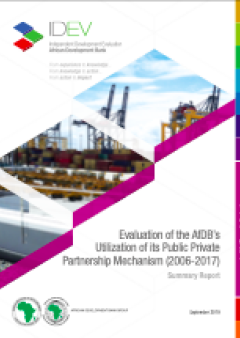
Evaluation of the Bank’s utilization of the Public Private Partnership Mechanism, 2006 – 2017
The objectives of the evaluation were:
- To assess the extent to which the Bank’s PPP interventions achieved development results;
- To assess the extent to which the Bank’s PPP interventions have been well-managed;
- To identify factors that enable and/or hinder the successful implementation and achievement of development results; and
- To harvest lessons from experience to inform the Bank’s future use of its PPP mechanism.
The evaluation was based on a “Theory-of-Change” approach and relied on mixed methods for collecting and analyzing data at project, sector, corporate and country levels. It mainly used evidence synthesized from seven background reports, 11 project results assessments, non-lending reviews, five country case studies, sector syntheses, a portfolio review, and a benchmarking study.
The evaluation found that the Bank has neither an overarching and formal strategy, nor operational guidelines and directives for PPPs. It has generally addressed PPPs within its corporate and sectoral strategies and country strategy papers. The Bank does not have a central PPP unit, but employs a decentralized PPP matrix approach instead. This means that several units within the Bank handle PPP activities, with occasional overlaps, and without the necessary coordination.
In terms of project performance, however, the evaluation found that the Bank’s PPP interventions are largely relevant and effective, with the benefits likely to be sustained. Upstream PPP operations, largely focused on the development of PPP-enabling laws and regulations and strengthening of PPP institutions at country level, were found to be aligned with the Bank’s operational priorities. The Bank’s downstream PPP support, largely in areas that were defined by the Bank’s corporate and sector strategies and policies, was found to have been satisfactory, and its interventions achieved their targeted outcomes and impacts. In managing PPPs, the Bank was found to be innovative and demand-driven, but it was mainly reactive and faced major challenges, including implementation delays and inadequacies in quality at entry, supervision, and monitoring activities.
In terms of synergies and coordination of the projects, the report found that inside the Bank, despite the lack of a formal coordination mechanism, most projects were coordinated successfully across all key departments and units, with few instances of inadequate coordination between the public and private sector operations of the Bank. Outside the Bank, its responsiveness, contextual understanding, partnership-based approach and support to investor confidence were all appreciated by external stakeholders, but some areas for improvement were highlighted, including low visibility of the Bank’s plans and activities compared with other multilateral development banks, limitations in country staff capacity, and restrictive approval processes.
The evaluation made recommendations for the Bank’s Management to consider at the strategic and operational levels to improve internal efficiency and the effectiveness and impact of PPPs on the continent. Some of them are:
- Clearly define a strategic framework for the Bank’s participation in the continent-wide PPP agenda to improve internal efficiency, and PPP effectiveness and impact;
- Strengthen and improve coordination between upstream and downstream interventions.
- Continue strengthening communication with external stakeholders on the Bank’s PPP agenda in specific sectors;
- Establish a project knowledge repository, and leverage this repository to guide project development and implementation in RMCs.
- Continue strengthening PPP performance monitoring and reporting, and risk management mechanisms.
